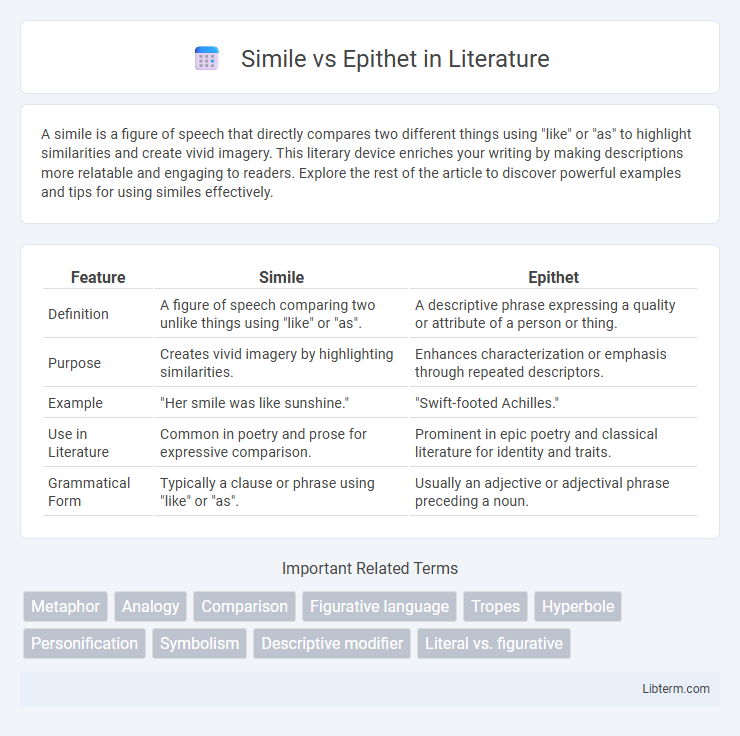A simile is a figure of speech that directly compares two different things using "like" or "as" to highlight similarities and create vivid imagery. This literary device enriches your writing by making descriptions more relatable and engaging to readers. Explore the rest of the article to discover powerful examples and tips for using similes effectively.
Table of Comparison
| Feature | Simile | Epithet |
|---|---|---|
| Definition | A figure of speech comparing two unlike things using "like" or "as". | A descriptive phrase expressing a quality or attribute of a person or thing. |
| Purpose | Creates vivid imagery by highlighting similarities. | Enhances characterization or emphasis through repeated descriptors. |
| Example | "Her smile was like sunshine." | "Swift-footed Achilles." |
| Use in Literature | Common in poetry and prose for expressive comparison. | Prominent in epic poetry and classical literature for identity and traits. |
| Grammatical Form | Typically a clause or phrase using "like" or "as". | Usually an adjective or adjectival phrase preceding a noun. |
Introduction to Simile and Epithet
Simile is a figure of speech that compares two different things using "like" or "as" to highlight similarities and create vivid imagery, enhancing descriptive expression in writing. Epithet is a literary device that attributes a distinctive quality or characteristic to a person, place, or thing, often through descriptive adjectives or phrases, to emphasize specific traits and evoke emotional responses. Both simile and epithet enrich language by adding depth and clarity to descriptions, making narratives more engaging and memorable.
Defining Simile: Meaning and Purpose
A simile is a figure of speech that directly compares two distinct things using connecting words such as "like" or "as," aiming to create vivid imagery and enhance understanding by highlighting similarities. Its purpose is to evoke sensory experiences and clarify concepts by drawing relatable parallels in literature, poetry, and everyday language. Unlike an epithet, which attributes a descriptive quality or characteristic to a noun, a simile functions as an explicit comparative tool to enrich expression.
Understanding Epithet: Meaning and Function
An epithet is a descriptive term or phrase expressing a characteristic quality of a person or thing, often used to highlight a distinctive trait or attribute. It functions as a concise literary device that enriches characterization and adds emotional or symbolic depth to the subject. Unlike similes, which create comparisons using "like" or "as," epithets directly name or describe qualities, making them integral to both classical and modern literature for emphasis and vivid imagery.
Key Differences Between Simile and Epithet
Similes explicitly compare two different things using "like" or "as," enhancing imagery by highlighting similarities, such as "Her smile was like sunshine." Epithets assign descriptive adjectives or phrases directly to a noun to emphasize characteristic traits, like "Alexander the Great," which conveys fame and power without comparison. The key difference lies in similes creating vivid comparisons for effect, while epithets serve as fixed, attributive labels that deepen the identity or qualities of the subject.
Common Examples of Simile in Literature
Common examples of simile in literature include Shakespeare's "as brave as a lion" in Henry VI and Robert Burns' "O my Luve's like a red, red rose" comparing love to a rose. Similes use "like" or "as" to create vivid imagery and highlight similarities between two different things. In contrast, epithets employ descriptive phrases, such as Homer's "swift-footed Achilles," to characterize or emphasize traits without direct comparison.
Popular Examples of Epithet in Writing
Epithet is a literary device that attributes a characteristic quality to a person or thing, often using descriptive adjectives or phrases, enhancing imagery and emotional impact in writing. Popular examples include Homer's "rosy-fingered dawn" and "swift-footed Achilles," which vividly encapsulate key traits and elevate the narrative's poetic quality. Unlike similes, which draw direct comparisons using "like" or "as," epithets embed descriptive identity, reinforcing thematic elements and character presence throughout a text.
Impact of Simile on Imagery and Expression
Similes enhance imagery by creating vivid comparisons that evoke strong sensory experiences, making abstract concepts more tangible and relatable. They heighten emotional expression by linking familiar images to complex ideas, intensifying readers' engagement and understanding. Distinct from epithets, similes actively construct dynamic visual scenes rather than merely attributing fixed qualities to a noun.
The Role of Epithets in Characterization
Epithets serve as concise descriptive phrases that highlight distinctive traits of characters, enriching their portrayal by embedding key attributes directly into the narrative. Unlike similes, which create comparisons using "like" or "as," epithets function as integral identifiers, strengthening the reader's perception of a character's role, personality, or status. This technique enhances characterization by providing immediate, memorable associations, often reinforcing cultural or mythological significance within literature.
When to Use Simile vs. Epithet
Similes are best used when a clear, imaginative comparison enhances the reader's understanding by linking two different things using "like" or "as." Epithets work well for adding descriptive qualities to a noun, often emphasizing an inherent characteristic without the need for a direct comparison. Choose similes to create vivid imagery and epithets to reinforce traits or evoke emotions succinctly in poetry or prose.
Conclusion: Choosing the Right Device
Selecting between a simile and an epithet depends on the desired impact in literary expression; similes create vivid comparisons using "like" or "as" to enhance imagery, while epithets assign descriptive titles that encapsulate a character's essence. Writers aiming to evoke clear, imaginative visuals often prefer similes for their explicit relational clarity. In contrast, epithets concisely convey inherent qualities or thematic significance, making them ideal for reinforcing character identity or symbolic meaning.
Simile Infographic

 libterm.com
libterm.com